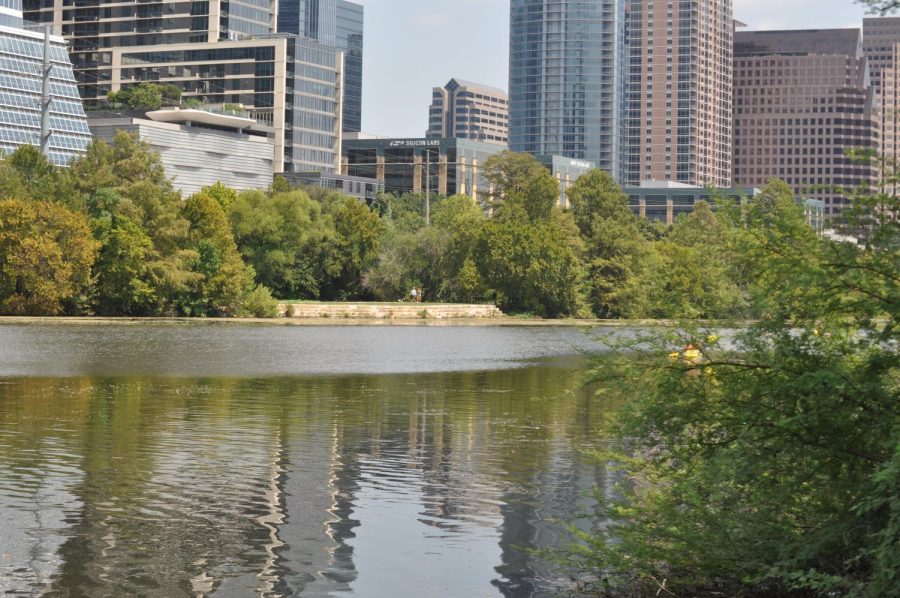Lady Bird Lake Lacks Legitimate Liquid Levels
WALKING AROUND THE LAKE: Austinites have enjoyed walking around Lady Bird Lake for years, but recently there has been more algae in its water. Dogs are the most prone to illness and death from the cyanobacteria, and people are still not advised to swim. Photo by Zia Harvey
October 27, 2022
Since 2019, the water in Lady Bird Lake in Austin has been considered unsafe to swim in, especially for pets, according to the City of Austin. In recent years, dogs have passed away after swimming in the lake due to toxic algae, which can also be harmful to humans.
Brett Bellinger, a botanist working for the City of Austin, heard about the dog deaths and started investigating the infested waters. He points to cyanobacteria, also known as blue-green algae, as the main cause responsible for the deaths. According to Bellinger, cyanobacteria are in all bodies of water, but normally, not abundant enough to pose a danger to life. Starting in 2019, Bellinger said there was enough cyanobacteria in Lady Bird Lake to produce dangerous levels of toxins.
“2019 is when some dogs died, and we started monitoring and observing the neurotoxin and the likely drivers are changes in the nutrient availability,” Bellinger said. “Again it is a lot of things that come together. It is not specifically known, but it’s summer time, hot water, and low flow, which means you’re not flushing out the cyanobacteria and nutrients to grow.”
Junior Anna Williams rows for Texas Rowing Club, which holds practices on Lady Bird Lake. Williams practices about 5 times a week at the lake but said the toxic waters haven’t affected her practices much.
“When we’re rowing we shouldn’t really be in the water anyways, but I do get splashed a lot,” Williams said. “I heard about the algae from people on my team, and my mom’s mentioned it to me, our coach mostly tells us to just not get in the water.”
Cyanobacteria is a photosynthetic bacteria, which means it’s able to photosynthesize and create dangerous toxins. Bellinger says that the toxins from cyanobacteria can affect every organ, and can even cause cancer, but the species of cyanobacteria in Lady Bird Lake specifically produces neurotoxins that are only harmful to humans if large amounts are ingested.
“Essentially if you are exposed to too much of [the neurotoxin] you will have seizures,” Bellinger said. “Physiological activities, something as simple as breathing, all comes down to electrical impulses, and the neurotoxin affects those processes. It could be depending on how much neurotoxin you are exposed to. You could have tremors, seizures, or you could just stop breathing entirely.”
Bellinger adds that the algae is more dangerous for animals because it only causes illness when ingested, such as when a dog grooms themselves. Accidentally drinking the water from the lake won’t cause as much harm as directly ingesting the algae itself.
“The neurotoxin we have here in Austin has not been found in the water, so that’s good,” Bellinger said. “It has only been found in the algae, so you have to consume the algae to get the toxin. So that’s why it affects dogs more, they get the algae on them, and when they clean themselves or groom themselves, they ingest the algae. Then they release the toxin into their systems.”
The city has issued several warnings about the contaminated water, in order to try and keep people and pets away from the dangerous areas. District 4 City Council member Chito Vela said the city is raising awareness about the algae and is trying to prevent it. Vela said the city has put out websites, social media posts, newspaper articles, and television announcements about the hazard.
“Right now the city is warning folks who are in the places that it has been found, the creeks and the river itself, be careful with swimming and keep your dogs out of it,” Vela said. “The city is also putting clay that kills the algae in the areas that it has been found.”
Bellinger says it’s hard to specifically work to reduce the cyanobacteria itself. Instead, they need to reduce the ideal factors that help with bacteria growth.
“We are investigating some options that target nutrients, but the mitigation strategy would not work in all systems,” Bellinger said. “As such, we really need citizens throughout the watershed to do their part to reduce inputs of sediments and nutrients to contributing creeks and rivers.”
According to their website, the city is currently testing a measure to reduce the amount of phosphorus in the lake, which the toxic cyanobacteria thrive on. By adding phos-lock –a type of clay that binds to phosphorus– phosphorus levels can be reduced.
“I think adding clay will probably be the best way to prevent it from forming,” Vela said. “Or moving the water, because stagnant water makes it [the cyanobacteria] more abundant.”
While the water is mainly unsafe for animals, it can still cause illness in humans. Vela said the lake water undergoes regular testing every two weeks, but is not 100% safe for humans yet.
*Written by Aidan Gannon with contributions from Malvika










